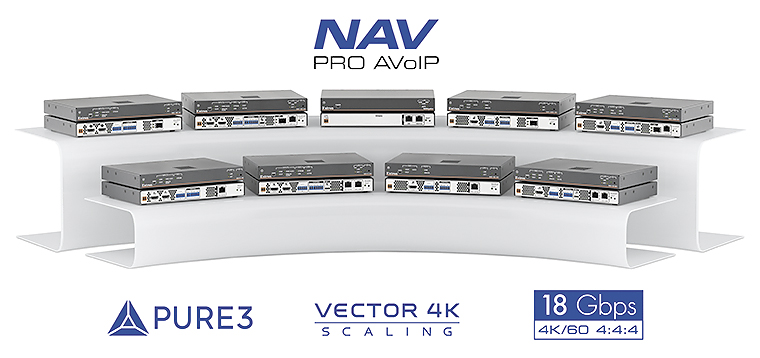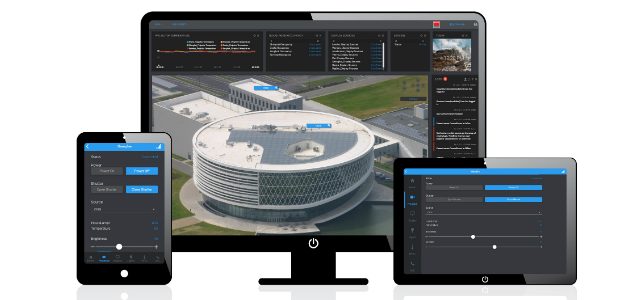Complete Control
Creating AV Control Systems That Provide the Ideal User Experience
Though it’s always been an incredibly important facet of systems integration, the focus on user experience has come to the forefront as users become more comfortable with advances in consumer technology. And in few areas does that confluence of consumer experience and the commercial AV space become more apparent than in control systems.
“The control system is often the most visible part of the entire AV installation, and the experience the customer has with it determines their satisfaction with the system as a whole,” said Joe da Silva, director of product marketing, Extron. “Regardless of system scope, keep the focus on the importance of the customer’s experience.”
David Shamir, Atlona’s director of product management, agrees that this is one of the most important considerations for systems integrators to keep in mind when planning to incorporate an AV control system in a project. “The expectation from the end user is at the top of the list,” he said. “Understanding the end users and their expectations will alleviate misunderstandings and avoid unnecessary project delays.”
[Inside Panduit’s Acquisition of Atlona: ‘It’s All Positive’]
When it comes to control systems, the user experience can quickly become overcomplicated, especially as the number of devices and rooms increases. One of the keys to meeting a customer’s expectations is learning how to balance ease of use with oversimplification.
“Control system integration has a tendency to be composed of an intricate user interface, when the end users only want a few simple controls,” Shamir said. “Conversely, oversimplification of the control interface may be a detriment to the end user who requires access to complex features made invisible in a simple control interface design.”
What it ultimately comes down to is understanding users and their needs, which, as da Silva noted, is one of the keys for long-term success.
A daily selection of the top stories for AV integrators, resellers and consultants. Sign up below.
“Provide high-quality, reliable AV control systems that are easy to integrate, easy to implement, and easy to use,” he said. “No matter where technology takes us in the next five years, end user satisfaction ultimately defines our success.”
Determining the simplest—but not too simple—control system may be a delicate balancing act, but one aspect that’s helping to simplify the process for integrators might be the increasing prevalence of AV over IP.
[Extron Launches 1Gb-10Gb Interoperable AV over IP Platform]
“The transition of AV systems to IP networks for distribution and management has taken off, which means that more systems are now being controlled over the network. The expectation is that the control system will be no different, yet will be IP-based,” said Shamir. “The days of a control processor dedicated for each meeting space are slowly going away. Customers are seeking IP-based systems that can reside in a centralized location, and can be used as a shared processing resource for all AV systems installed in meeting spaces.”
The proliferation of AV over IP systems has added benefits for both end users and integrators, Extron’s da Silva noted. “AV over IP technology enhances AV capabilities in several ways, including globally extending visual communication, increasing scalability, and simplifying cable infrastructure, to name a few.”

Extron NAV
Extron’s NAV Series is an AV over IP platform that distributes and switches ultra-low latency, pixel-perfect video, audio, and USB 2.0 signals over Ethernet networks. The NAV Series features the PURE3 codec to enable real-time transmission of visually lossless video at low bit rates.

AMX NX-4200
For large-scale installations with stringent security requirements, the AMX NX-4200 controller features dual NIC with POE, which enables two discrete network interfaces and includes a 4-port switch with PoE, so it can power PoE devices over a secure, isolated network.

Atlona Velocity
Atlona’s networked IP-enabled AV control platform, Velocity Control System, comprises three distinct elements that work together as a single, unified platform.

Kramer VS-88UT
Kramer’s VS-88UT switches video, embeds audio, and outputs signal via both HDMI and HDBaseT 2.0 with USB extension and PoE on the HDBaseT output ports. Plus, the VS-88UT includes a master room controller that can operate over Ethernet (LAN) with control ports that include a bidirectional RS−485, four RS−232, four IR, four GPI/O, and eight relays to control a wide variety of AV devices.

Barco Overture Cloud
The Overture Cloud solution runs on Barco’s cloud and supports a variety of AV devices and equipment (and brands), with more continually added to the list of supported devices.
Extron’s NAV Series demonstrates these capabilities. An AV over IP platform that distributes and switches ultra-low latency, pixel-perfect video, audio, and USB 2.0 signals over Ethernet networks, the NAV Series features the PURE3 codec to enable real-time transmission of visually lossless video at low bit rates. The NAVigator System Manager, part of the NAV Series, offers a user-friendly interface for centralized management, configuration, and control of NAV systems.
“When it comes to AV control, this technology virtually eliminates traditional distance limitations,” said da Silva. “NAV endpoints have built-in Pro Series control ports for CEC, RS-232, and IR, effectively expanding Extron Pro Series control systems beyond the physical location of the control processor.”
[Cloud Video to Surpass 25 Percent of Enterprise Video Market by 2023]
Meanwhile, some control is moving toward the cloud. One obvious benefit of cloud-based control is remote observation and operation, but Atlona’s Shamir notes there are more opportunities to it than that.
“Cloud-accelerated AV control systems will leverage the massive storage and computing power available in the cloud for data analytics, disaster recovery, and remote connectivity,” he said.
Atlona’s networked IP-enabled AV control platform, Velocity Control System, comprises three distinct elements that work together as a single, unified platform. The first element is the Velocity Control Suite, a cloud-based service and centralized resource that enables integrators to create, organize, and manage their AV control projects by client, client sites, and AV control systems. The innovative cloud and on-premise system architecture enables scalability for up to 500 room systems or more, as well as full redundancy capability that avoids downtime across a client’s AV control installation. The system also includes the Velocity Control Gateway, a software-based control processor that resides on-site with the client’s AV systems and delivers IP control to Atlona and third-party devices, and Velocity Touch Panels, which are available in 5.5- and 8-inch screen sizes and include hardware for wall or surface mounting.
Another system with cloud- and premise-based options is Barco’s Overture. The Overture Cloud solution runs on Barco’s cloud and supports a variety of AV devices and equipment (and brands), with more continually added to the list of supported devices. It doesn’t require proprietary hardware, and in-room control can be provided through any HTML5-compatible device, including BYOD devices.
[Voice Control in the Conference Room]
Another top concern for users continues to be security. For large-scale installations with stringent security requirements, the AMX NX-4200 controller features dual NIC with POE, which enables two discrete network interfaces and includes a 4-port switch with PoE, so it can power PoE devices over a secure, isolated network. The LAN port is used to connect the master to an external network, and the ICSLAN ports connect to AMX or third-party AV equipment isolated from the primary network.
The NX-4200 also answers another primary user concern: reliability. With the NX-4200, power can be supplied directly from AC sources and on 12V DC. If the AC power fails, the system switches to 12V DC automatically, without interruption. That backup capability extends to the network ports, and there are diagnostics for the serial and IR connections that provide real-time error feedback.
For those systems that call for an all-in-one solution combining a presentation system with integrated range extension and an integrated controller, Kramer’s VS-88UT fits the bill. The unit switches video, embeds audio, and outputs signal via both HDMI and HDBaseT 2.0 with USB extension and PoE on the HDBaseT output ports. Plus, the VS-88UT includes a master room controller that can operate over Ethernet (LAN) with control ports that include a bidirectional RS−485, four RS−232, four IR, four GPI/O, and eight relays to control a wide variety of AV devices. The included KNET connector interface provides access to the master controller from auxiliary room controllers such as control keypads.
Whatever control system is the best choice for the project at hand, time expenditure remains a vitally important consideration, according to Atlona’s Shamir. “How long it will take to create, program, and install the control system? Time is money, and programing is money,” Shamir explained. “Reducing the dollar amount allocated to programing and accelerating the installation process allows the integrator to pass on savings to the end customer. That instantly makes the integrator more competitive to win business without degrading the technical end result, and without any user/human interface compromises.”
